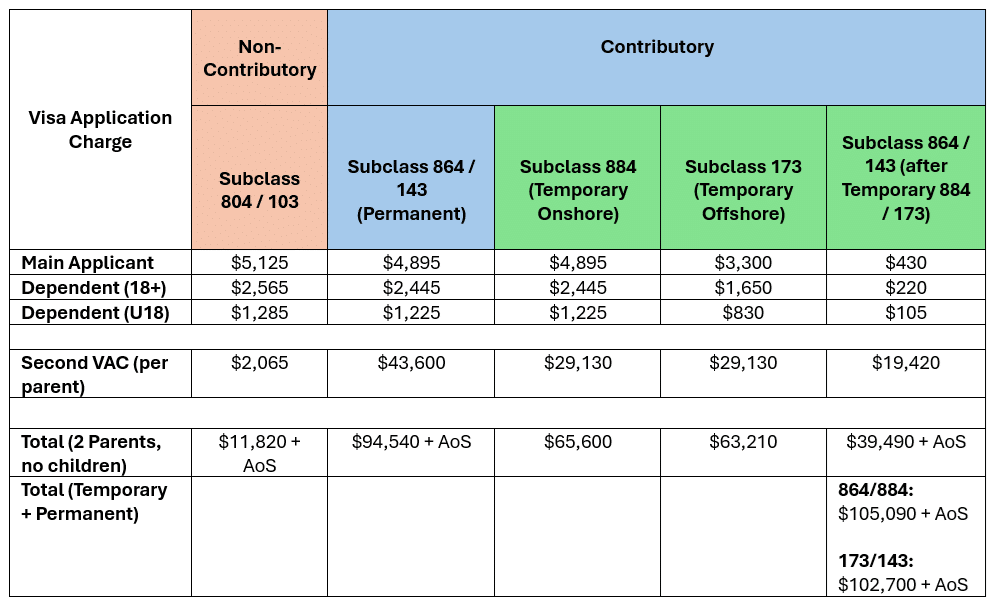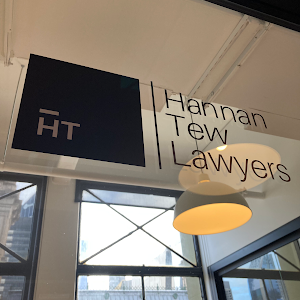
There are six different permanent Australian Parent visas and navigating the various visa options to decide which one best suits your family’s circumstances can be daunting. Even if your parents appear eligible, there are many other considerations, intricacies regarding making a valid application, and steps to be taken before the visa can be approved. Given that Parent visas also vary greatly in timing and costs, knowing in advance what amounts will be payable and when, might also be an important factor for you.
Getting some advice on which type of parent visa suits your family best or receiving assistance for the entire matter may help bring you peace-of-mind and most importantly, ensure the best possible outcome.
This article summarises the various permanent Parent visas and points of consideration including:
- the Contributory vs Non-Contributory visas;
- the onshore (“Aged”) vs offshore visas;
- the Balance of Family Test;
- the Sponsor requirements;
- capping and queuing;
- health and character;
- the Assurance of Support; and
- costs.
Contributory vs Non-Contributory Parent visas
Permanent Parent visas can be broken down into two main categories:
Non-Contributory Parent visas
These visas:
- have a relatively low second visa applicable charge payable ($2,065);
- are currently taking around 30 years to process.
Contributory Parent visas
These visas:
- have a high second visa applicable charge payable ($43,600 per parent);
- are currently taking around 12 years to process.
There are also two types of Contributory Parent visas, being:
- permanent Contributory Parent visas – which confer immediate permanent residency; and
- temporary Contributory Parent visas – which are valid for 2 years, to facilitate the later lodgment of a permanent Contributory Parent visa.
The temporary Contributory Parent visa serves as a mechanism to split up the significant second visa application charge for the permanent Contributory Parent visa (discussed in further detail below). While taking this approach results in paying slightly more per parent, it provides a lot more time to save the total amount.
What’s the trade off?
The trade-off between these parent visas is the time taken to process versus the significantly higher cost. However, in practice, the non-Contributory parent visas are unlikely to ever receive a decision so are usually not effective unless there is some alternative strategy (for example obtaining a Bridging visa with an Aged application). However, given Contributory parent visas submitted at this stage will also have a significant processing time, families might consider whether it is beneficial to wait for a non-Aged parent to become Aged.
Aged vs Non-Aged Parent visas
Parents are eligible for different visa subclasses based on their age. In order to apply for the onshore Parent visas (i.e. apply in Australia and receive a Bridging Visa) the main applicant parent must be an ‘aged parent’.
Aged Parent visas
In order to satisfy the ‘aged’ criteria, the main applicant must be eligible to receive the Australian aged pension (see here).
The visas available are:
- the temporary Aged Contributory (Subclass 884) Parent visa;
- the permanent Aged Contributory (Subclass 864) Parent visa; and
- the permanent Aged (Subclass 804) Parent visa.
In summary:
Visa |
Length of Stay |
Bridging Visa issued (if lodged onshore)? |
Estimated Processing Time |
Assurance of Support required? |
Subclass 884 |
2 years | Yes | 12 Years | No |
Subclass 864 |
Permanent | Yes | 12 Years | Yes |
Subclass 864 (as the holder of a Subclass 884) |
Permanent | Yes | 12 Years | Yes |
Subclass 804 |
Permanent | Yes | 30 years | Yes |
You will need to be inside Australia both at time of visa application lodgment and at time of visa decision.
Non Aged Parent visas
If your parent is not yet of an age to be eligible for the Australian aged pension, they can only apply for one of the non-aged (offshore) visa options. This means they would not receive a Bridging Visa. The non-aged visas are as follows:
- temporary Contributory Parent (Subclass 173) visa;
- permanent Contributory Parent (Subclass 143) visa; or
- permanent Parent (Subclass 103) visa.
Visa |
Length of Stay |
Applicant’s location at lodgment |
Applicant’s location at decision |
Bridging Visa issued (if lodged onshore)? |
Estimated Processing Time |
Assurance of Support required? |
Subclass 173 |
2 years | In or outside Australia | Must be outside Australia | No | 12 Years | No |
Subclass 143 |
Permanent | In or outside Australia | Must be outside Australia | No | 12 Years | Yes |
Subclass 143 (as the holder of a Subclass 173) |
Permanent | Must be in Australia | In or outside Australia | Yes | 12 Years | Yes |
Subclass 103 |
Permanent | Must be outside Australia | Must be outside Australia | No | 30 years | Yes |
Meeting the ‘Balance of Family Test’
Only parents who meet the balance of family test can be sponsored for Australian permanent residency.
Parents meet the balance of family test by showing that at least half of their children are “eligible children”. An eligible child is:
- an Australian citizen; or
- Australian Permanents residents usually resident in Australia; or
- eligible New Zealand citizens usually resident in Australia.
Examples:
- 2 Australian Citizen/PR children and 2 who are not meets the requirement
- 1 Australian Citizen/PR child, 1 child overseas, and 1 child in Australia but on a temporary visa does not meet the requirement
- 1 Australian Citizen/PR child and 2 children who are deceased meets the requirement
We have also have a separate blog post which explains the balance of family test in further detail.
Who can be the sponsor?
The Sponsor for the immigration process must be:
- a settled Australian citizen; or
- a settled Australian permanent resident; or
- a settled eligible New Zealand citizen.
Settled is defined as being lawfully resident in Australia for a reasonable period. Under Departmental policy, this is considered approximately 2 years (though there are some other considerations around this).
If the Australian child is:
- over 18 years of age – their own spouse or de facto partner can act as the sponsor; or
- under 18 years of age – another legal guardian or a community organisation can act as the sponsor on the child’s behalf.
Capping and queuing
The Australian Government ‘caps’ the number of each Parent visa subclass that can be granted each migration program year (1 July to 30 June). When the cap is reached, no further visas of that type can be granted that year. So, any pending applications are ‘queued’ for consideration in the subsequent year.
Applicants are considered for visa grant in the order of their queue date. After lodgment, the Department generally advises in writing when your application has been queued.
The Department offers some general information here on which visa applications have been released for final processing.
Health and character
For all Australian parent visas, the applicants (i.e. Parents) will need to satisfy the health and character requirements.
Generally, character is met by providing police clearances from each country the applicant has spent a cumulative 12 months in, over the last 10 years.
Health is met with a health examination organised through BUPA for onshore applicants, or through an authorised panel physician for offshore applicants.
If an applicant has any health or character concerns, it is important to get some more tailored advice so you can understand the relevant risks.
Assurance of Support
Towards the end of permanent parent visa processing, the Department of Home Affairs will request evidence that an Assurance of Support (Aos) has been arranged.
An AoS is not required for the temporary Contributory Parent visas (Subclass 173 and 884), but would be if the person later applied for the permanent Contributory Parent visa.
The AoS is not a fee, but a bond that is assessed by the Department of Human Services (DHS). It provides ‘assurance’ that the visa applicant won’t need to rely on social welfare payments once they become a permanent resident.
DHS has an online calculator here, which can give you an estimate of what the AoS will be based on your circumstances and family composition.
To be an Assurer, DHS generally requires you:
- Pass the income test for the current and previous financial year
- Be an Australian resident
- Be at least 18 years old
- Provide proof of identity
It is common that the Sponsor will also assume the role of the Assurer. However, it is not actually mandatory to be both. If the Sponsor cannot meet the AoS requirements on their own, a partner or sibling can assist. In other words, there can be a different or multiple Assurers.
AoS Bank Guarantee
A bank guarantee (or ‘bond’) is requested if your Aos application is approved.
The amount of the bank guarantee depends on whether:
- the Assurer is an individual or an organisation
- there are 1 or 2 adult Assurees (i.e. 1 or 2 parents)
- the AoS is for 2, 4, or 10 years.
For an AoS that is 2 or 4 years the guarantee is:
- $5,000 for 1 adult
- $7,000 for 2 adults
For an AoS that is 10 years the guarantee is:
- $10,000 for 1 adult
- $14,000 for 2 adults
As long as the Assuree (parent) does not receive any payments from the Department of Human Services, the bank guarantee will be cancelled at the end of the assurance period and the remaining funds released back to you. Any payments taken from the Assuree will initially be taken from the AoS deposit.
Cost
To validly apply for a Parent visa, all applicants will need to pay an initial Visa Application Charge (VAC).
If the Department are satisfied that all the criteria will be met, they will subsequently request a payment of the second VAC. In the case of a Contributory Parent visa, this is the significant component that must be paid (noting there is a significantly lower fee for under-18 dependents who were included at time of application).
You can find a loose breakdown of these costs below, including a sample costing of sponsoring two parents:
The cost of the offshore Subclass 103 visa and Subclass 143 visa are the same as their onshore equivalents, being the Subclass 804 and Subclass 884. There is a slight difference between the offshore Subclass 173 and onshore Subclass 884.
Conclusion
Given the lengthy processing times involved with Parent visas, and the high cost, it is sometimes worth getting legal advice to ensure that you’ve selected an approach that is consistent with your needs, timeframes, and budget.
You may want assistance from experienced professionals to otherwise guide you through a sometimes-stressful process. Hannan Tew Lawyers have assisted a significant number of families seeking advice and assistance on Australian parent visas, and have even facilitated more appropriate options for certain clients saving them money and time.
Please feel free to contact us by email at [email protected] or phone +61 3 9016 0484 if you’d like some guidance or assistance with the next steps.



Hi,
I’m applying for a 143 and is confused by part H in form 47PA, is this part required? Is a form 47A also required to be filled out by my partner who’s migrating with me and my child who is sponsoring?
Also what are your fees for assistance with this application? Thanks
Hi there,
THanks for reaching out.
Form 47A will normally only be required if you have a child over the age of 18 who will be included in the applicaiton (so not one required for your sponsor). Similarly, Part H of 47PA only needs to include children over the age of 18 who are included in the application.
Our fees for advice and assistance for a Parent visa application start from $4,400.
Feel free to contact us at [email protected] if you’d like to discuss further.
Kind regards,
Hannan Tew